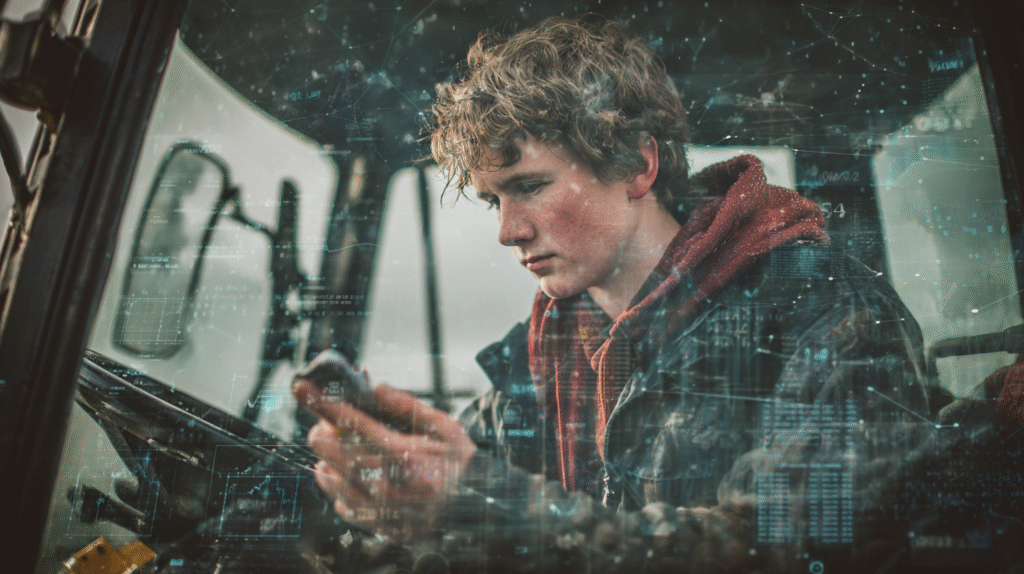There’s a subtle but sure revolution happening across the British countryside, and you won’t spot it in a headline or an annual review — you’ll see it in the cab of a tractor. There’s a younger farmer at the helm, phone in hand, flipping between yield maps, WhatsApp groups and weather radars while the tractor glides along neatly on auto-steer.
It’s subtle, almost unassuming, but it’s exactly the kind of shift that changes everything. Because these younger digital-minded farmers aren’t just farming differently — they’re thinking differently. And that mindset is transforming how data is used across UK agriculture.
From Gut Feeling to Actual Insight
Farming has always been a dance between instinct and experience — but now there’s data, and lots of it. Soil sensors, drone imagery, machine telematics, moisture probes, mapping tools… the list grows longer every year. The irony, of course, is that many farmers now say they’re drowning in data but still thirsty for clarity. It’s one thing to generate a spreadsheet’s worth of numbers; it’s another to know what on earth to do with them.
This is precisely where younger farmers shine. They don’t see dashboards as chores — they see them as shortcuts. They’re quicker to spot patterns, to question anomalies, to tweak decisions mid-season rather than waiting for the next one. That shift alone is worth its weight in gold (or, at the very least, in nitrogen saved and yields nudged upward).
The New “Data Leads” On British Farms
Let’s be honest: every farm has “the person who deals with the tech”. Increasingly, that person is the younger generation — whether they’re 25 or 45. Age isn’t the defining factor; mindset is.
They’re the ones:
- plugging in the sensors
- testing out a new app without needing a manual
- setting up cloud storage before anyone else discovers the password
- translating graphs into decisions the whole family can get behind
They’re doing on the farm what they’ve always done in life: learning fast, experimenting, adapting, and moving on if something doesn’t work. No fuss, no drama.
Why This Matters So Much For Britain
UK agriculture is under pressure from every direction — margins, labour, policy changes, unpredictable weather, you name it. So tools that help farmers become more efficient, more resilient and more informed aren’t just “nice-to-haves” anymore — they’re essential.
Digital data is becoming central to:
- boosting productivity
- reducing inputs without sacrificing yield
- proving environmental performance
- managing risk in an increasingly volatile climate
- building stronger supply-chain relationships
Younger farmers approach these challenges with a natural ease. They expect real-time information. They expect systems to sync. They expect technology to help them make better decisions. And they’re usually right.
Letting Farm Data Travel Further Than the Farm Gate
One of the biggest transformations happening is the idea that data shouldn’t sit unused on a dusty laptop in the office. Younger digital-savvy farmers are connecting their data to all sorts of external systems — traceability platforms, environmental schemes, logistics tools, carbon markets, even marketing channels.
Data becomes something with value, not just another file you swear you’ll “look at properly later.”
The result? New market opportunities, streamlined operations, and a far clearer understanding of what’s happening across the business.
Smarter Decisions, Not Just Bigger Datasets
Everyone loves a good gadget, but technology only earns its keep when it helps you make better decisions. And that’s where young digital mindsets come into their own.
They’re happy to:
- test something small
- compare results
- tweak it
- test again
- adopt it if it works
- ditch it if it doesn’t
No ego. No sentimentality. Just practical, iterative progress — the sort that genuinely moves a farm forward without the pain of sweeping, risky changes.
Of Course, There Are Hurdles
We can’t talk about digital adoption without mentioning the obvious pain points:
- patchy rural broadband that makes cloud tools a bit of a joke some days
- systems that refuse to talk to one another
- hardware and software that still feel too expensive for smaller farms
- and of course, the generational divide in confidence and training
Younger farmers often end up bridging that divide — explaining the tech upwards while pushing suppliers to build systems that feel less like a puzzle box and more like tools designed for real life on a real farm.
A New Kind of Stewardship
British farmers have always been stewards — of land, animals and the environment. But there’s a new kind of stewardship coming into play now: stewardship of information.
The next generation understands this instinctively. They’re not just logging data; they’re using it to strengthen the business, unlock new income streams, meet environmental goals, and build trust with the supply chain.
They see data as part of the farm’s future — not an add-on, and not a threat to tradition either, but a tool that supports it.
And honestly? If the future of British farming is being quietly steered by this switched-on, digitally fluent, keen-to-experiment generation… we’re in good hands.
Very good hands indeed.


